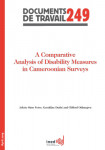A Comparative Analysis of Disability Measures in Cameroonian Surveys


En 1851 et pour la première en France, une variable relative à la quantification des populations infirmes est introduite dans un recensement français. Elle concerne les aveugles, les sourds-muets, les idiots, les crétins, les aliénés et les goitreux. Cette démarche s’inscrit dans un contexte favorable à la prise en charge et à l’étude de ces populations atteintes de difformités, de déficiences sensorielles ou mentales. Au cours du ...
Presented by: Berkay Özcan (LSE - The London School of Economics and Political Science) ; Discussant: Sander Wagner (CREST)
Pour expliquer des choix d’études, il faut, certes, s’intéresser aux propriétés et aspirations individuelles, mais il faut aussi accorder toute leur place aux contextes dans lesquels ces choix émergent. Cette présentation examine le rôle de ces contextes à partir du cas des rares hommes de formations dites « féminines » de l’enseignement supérieur, pour lesquels celui-ci est particulièrement saillant. De fait, rares ...


Author: Arnaud Régnier-Loilier While most couples have separate homes at the start of their relationship, some prefer to continue living apart for many months or years. Analysing data from the EPIC survey of individual and conjugal trajectories (Étude des parcours individuels et conjugaux) conducted in 2013–2014, Arnaud Régnier-Loilier examines the prevalence of non-cohabiting relationships and the characteristics of the people who ...


You are currently visiting the TeO2 survey website. The TeO2 survey (2019-2020) took place a decade after the first TeO survey (2008-2009). The ’Trajectories and Origins 2’ (TeO2) survey is a statistical survey conducted by both INED and INSEE. It is the second edition of a survey conducted in 2008-2009, which produced national statistics on the diversity of populations in metropolitan ...

The first edition of the survey (TeO1) in 2008-2009 shed light on a large number of issues concerning the role of origins in the processes of integration, discrimination and identity construction within French society. Analyzed by hundreds of researchers in France and abroad, the survey has been the basis for a large number of scientific publications. Nearly 150 were listed ...

Since the first ’Trajectories and Origins’ survey in 2008-2009, the issues of integration and discrimination within an increasingly diverse population have not lost their acuity in the French public debate. In a social context that has evolved since 2008, there has been a significant demand for a new edition of the survey, TeO2. One of its main objectives is to ...